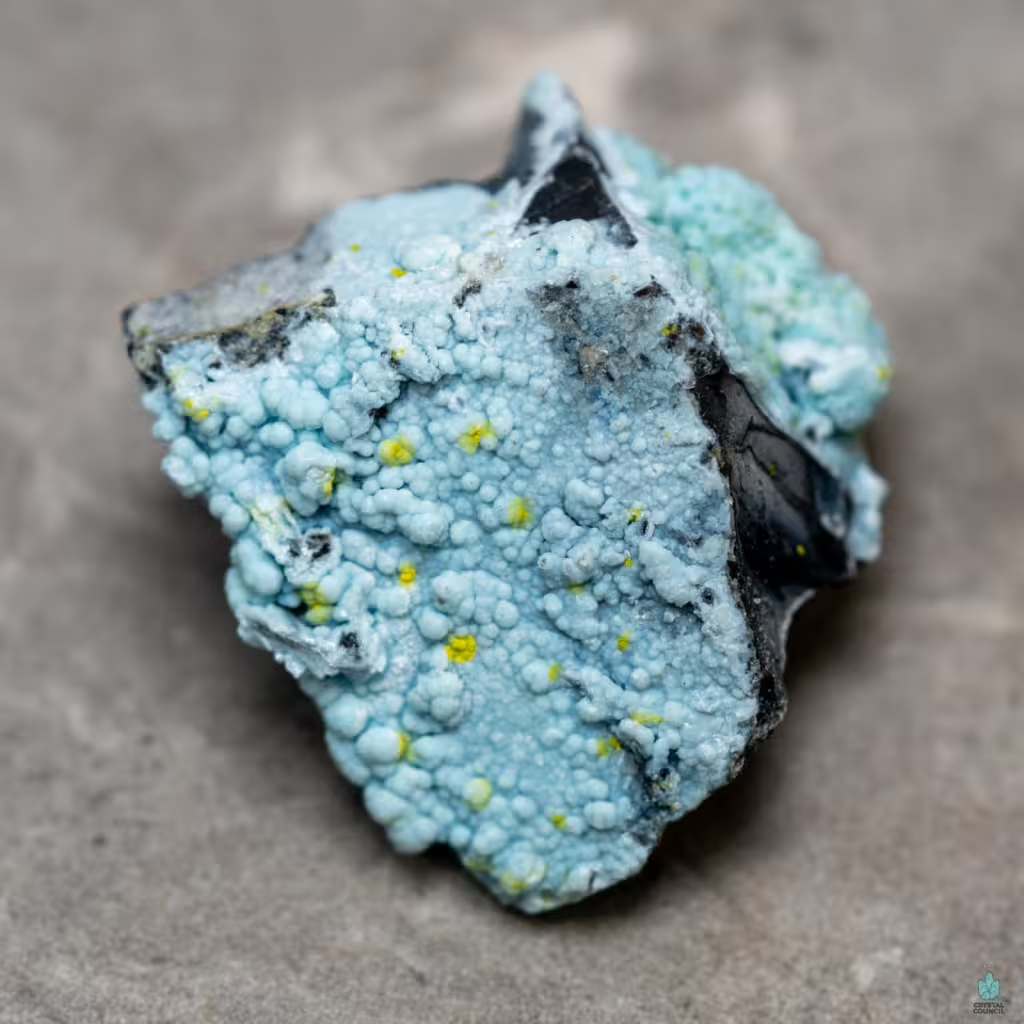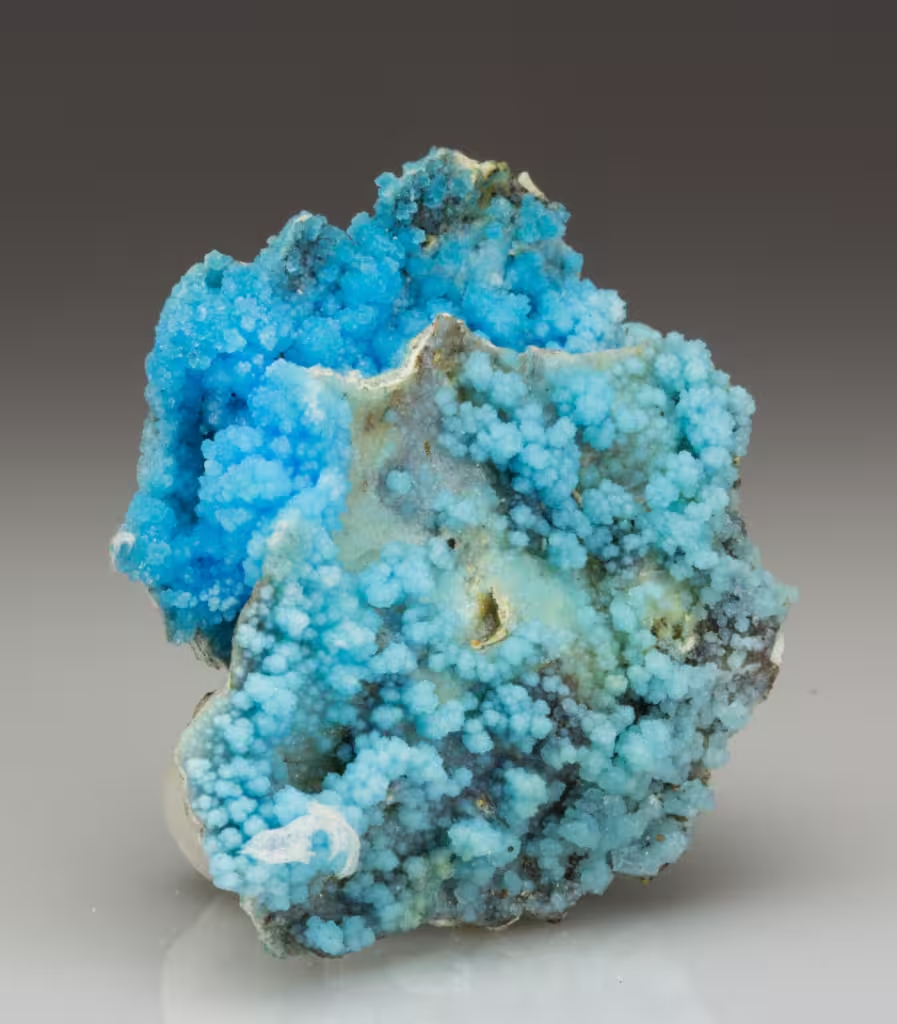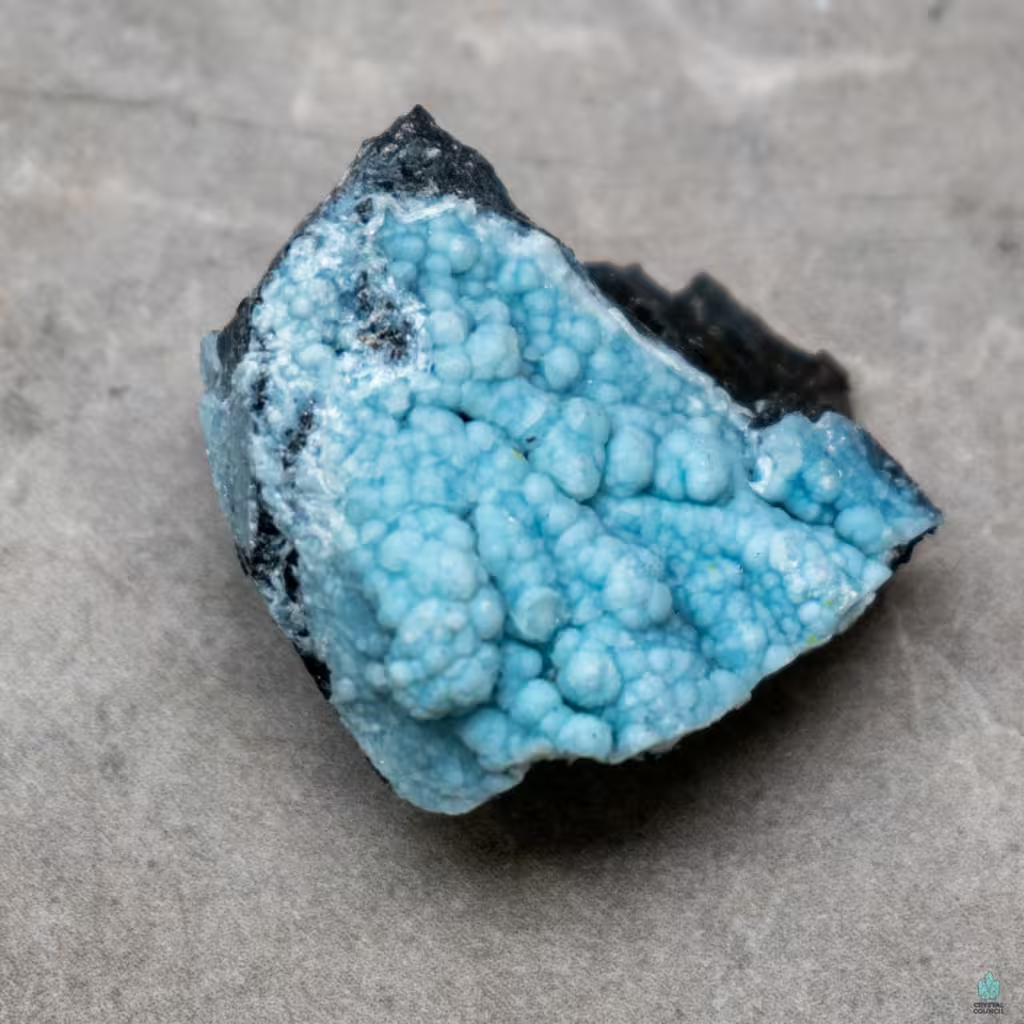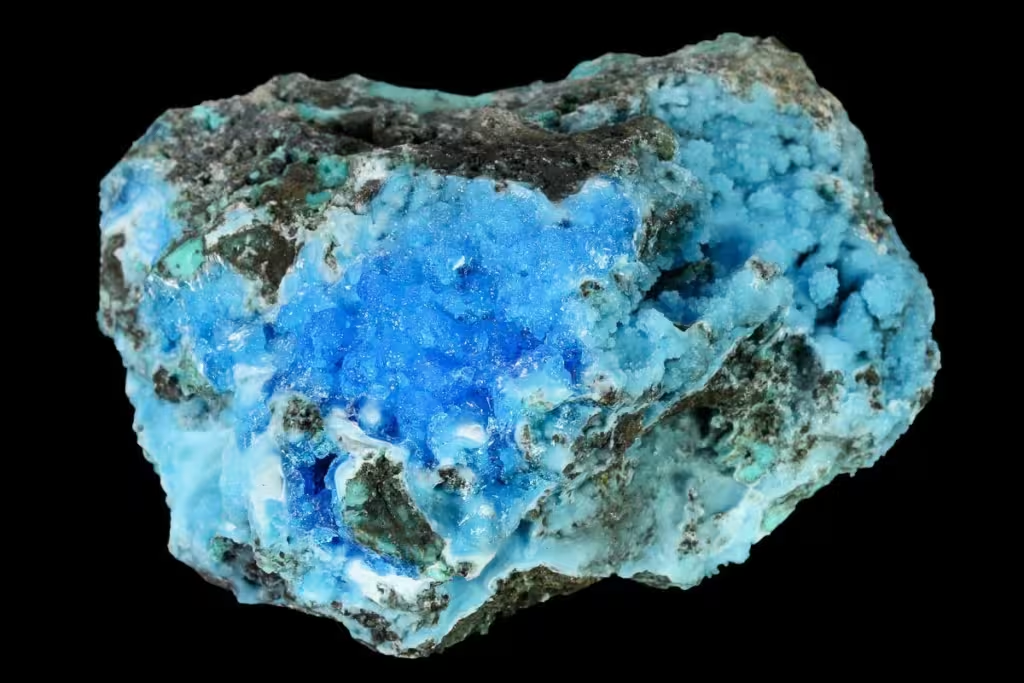Gibbsite is a naturally occurring mineral form of aluminum hydroxide with the chemical formula Al(OH)₃. It belongs to the hydroxides and oxides mineral class and is one of the three main components of bauxite, the primary ore of aluminum. Gibbsite appears as colorless to white or gray crystals, often displaying a pearly luster and typically forms in compact, botryoidal, or stalactitic masses.

Gibbsite was first described in 1822 by the American mineralogist Chester Dewey, who named it in honor of George Gibbs, a prominent American mineral collector and geologist. The mineral was initially identified in Richmond, Massachusetts, USA. Gibbs was known for his substantial contributions to mineralogy and his extensive mineral collection, which was one of the most important of his time.
Importance in Geology and Mineralogy
Gibbsite is of considerable significance in geology and mineralogy for several reasons:
- Aluminum Production: It is one of the primary minerals used in the Bayer process, where aluminum is extracted from bauxite ore. Gibbsite’s relatively high solubility in sodium hydroxide makes it particularly valuable in this process.
- Indicator of Weathering: In geological studies, gibbsite is considered an indicator of intense weathering in tropical and subtropical regions. It typically forms in highly weathered soils, especially in lateritic environments, which provide information about past climatic conditions.
- Study of Mineral Formation: Gibbsite’s formation process is studied to understand secondary mineral deposits, particularly in the context of lateritic bauxites. Its transformation from other aluminum minerals under different pH conditions provides insights into the geochemical cycles of aluminum.
Gibbsite, therefore, holds a central role in mineralogy, not only as an important ore of aluminum but also as a subject of study in understanding soil formation, weathering processes, and the environmental history of the Earth.
Physical and Chemical Properties of Gibbsite

Physical Properties
- Color: Typically colorless, white, gray, or light shades of yellow, green, or brown. The color variations are often due to impurities.
- Crystal System: Monoclinic, forming tabular or platy crystals, but it commonly appears in massive, botryoidal (grape-like clusters), or stalactitic forms.
- Luster: Vitreous (glassy) to pearly, especially on cleavage surfaces.
- Transparency: Transparent to translucent, depending on the presence of impurities.
- Hardness: 2.5 to 3 on the Mohs scale, making it relatively soft compared to other minerals.
- Cleavage: Perfect in one direction (basal cleavage) due to its layered structure, which allows for easy splitting along the plane.
- Fracture: Usually uneven or splintery.
- Density: Approximately 2.4 g/cm³, which is relatively low for a mineral, reflecting its hydroxide composition.
- Streak: White, regardless of the mineral’s surface color.
- Habit: Commonly found in pisolitic, massive, or botryoidal habits; also in stalactitic forms in bauxitic deposits.
Chemical Properties
- Chemical Formula: Al(OH)₃ — aluminum hydroxide.
- Composition: Composed of aluminum (34.6% by weight), oxygen (61.5%), and hydrogen (3.9%).
- Solubility: Insoluble in water but dissolves in strong acids and alkalis. In sodium hydroxide, gibbsite is relatively soluble, making it useful in the Bayer process for extracting aluminum.
- Stability and Alteration: Gibbsite is a stable mineral in tropical and subtropical environments where intense weathering occurs. Under varying conditions of pH, it can transform into other aluminum hydroxides or oxides like boehmite (γ-AlO(OH)) or diaspore (α-AlO(OH)), and eventually to corundum (Al₂O₃) under extreme temperatures.
- Reactivity: Gibbsite is relatively stable under normal atmospheric conditions. It can undergo thermal decomposition to form boehmite at around 200–300°C and γ-alumina at temperatures above 300°C.
- pH Dependency: As a hydroxide mineral, gibbsite’s solubility is highly pH-dependent. It tends to precipitate out of solution at neutral to slightly acidic pH levels, which is why it is commonly found in weathered soils and bauxite deposits.
Other Notable Characteristics
- Pleochroism: Gibbsite may exhibit weak pleochroism, appearing slightly different colors when viewed from different angles.
- Luminescence: Some gibbsite samples exhibit fluorescence under ultraviolet light, often glowing with a pale green or blue color due to trace impurities like iron or manganese.
These properties make gibbsite an important mineral for understanding weathering processes, geochemical cycles, and as a crucial resource in aluminum production.
Formation and Occurrence of Gibbsite

Gibbsite is primarily formed through the intense weathering of rocks rich in aluminum-bearing minerals such as feldspar, mica, and kaolinite. The key processes involved in its formation are:
- Chemical Weathering: Gibbsite is typically produced in tropical and subtropical climates, where high rainfall and warm temperatures accelerate chemical weathering. In these conditions, minerals like feldspar in granite and other igneous rocks undergo hydrolysis, releasing aluminum ions into solution. Over time, these aluminum ions precipitate as aluminum hydroxide (gibbsite) due to the breakdown of parent minerals.
- Lateritic Weathering: Gibbsite commonly forms in lateritic soils, which develop in tropical regions with high rainfall. In these environments, intense leaching removes most of the soluble elements (such as sodium, potassium, calcium, and magnesium), leaving behind relatively insoluble minerals like gibbsite. The process involves:
- Leaching: Rainwater, often slightly acidic due to dissolved carbon dioxide, percolates through the soil, leaching out silica and other soluble ions.
- Precipitation: As the concentration of aluminum in the soil increases, gibbsite begins to precipitate, forming secondary deposits.
- Alteration of Bauxite Deposits: Gibbsite is a primary component of bauxite, the principal ore of aluminum. Bauxite forms from the accumulation of gibbsite, boehmite, and diaspore in lateritic environments, often in low-lying areas such as plateaus or basins, where weathered material accumulates over long periods.
- Hydrothermal Processes: Gibbsite can also form in hydrothermal environments where hot, aluminum-rich fluids react with existing rocks, leading to the deposition of gibbsite in veins or fractures.
Occurrence
Gibbsite is found in a wide range of geological settings, primarily in areas with high rainfall and warm temperatures. Key occurrences include:
- Lateritic Bauxite Deposits: The most significant occurrence of gibbsite is in lateritic bauxite deposits, which are formed from the intense weathering of rocks in tropical and subtropical regions. These deposits are extensive in countries like:
- Australia: Particularly in Western Australia (e.g., the Darling Range), which hosts some of the world’s largest bauxite reserves.
- Brazil: In areas like the Amazon basin, known for its large lateritic bauxite deposits.
- Guinea: In West Africa, which has extensive deposits in regions like the Boké Plateau.
- India: Notably in the states of Odisha and Andhra Pradesh.
- Jamaica: Where significant bauxite deposits have formed in karstic (limestone) terrains.
- Weathered Igneous and Metamorphic Rocks: Gibbsite can also occur as a secondary mineral in deeply weathered zones of igneous and metamorphic rocks, particularly granites and gneisses. It forms through the alteration of feldspars and micas in such rocks.
- Soil Profiles: In lateritic and tropical soils, gibbsite can be found as a weathering product. These soils are typically red or reddish-brown due to the presence of iron oxides and can be found in tropical and subtropical regions around the world.
- Hydrothermal Veins: Occasionally, gibbsite is found in hydrothermal veins, particularly those associated with volcanic activity or geothermal fields where aluminum-rich fluids precipitate the mineral under specific conditions.
- Caves and Karst Environments: In karst environments (landscapes formed from the dissolution of soluble rocks such as limestone, dolomite, and gypsum), gibbsite can sometimes form as a secondary mineral in cave systems where aluminum-bearing solutions precipitate in underground settings.
Global Distribution
Gibbsite is globally distributed, but its most significant deposits are found in regions with:
- Tropical Climates: Characterized by high temperatures, abundant rainfall, and intense weathering.
- Stable Tectonic Settings: Where landmasses have remained above sea level for prolonged periods, allowing extensive weathering to occur without major tectonic disruption.
In conclusion, gibbsite forms primarily through weathering processes in warm, wet climates, and its occurrence is widespread across tropical and subtropical regions. It plays a crucial role in the formation of bauxite, the primary source of aluminum, making it an economically and geologically important mineral.
Gibbsite in Bauxite Ore

Role as a Primary Aluminum Ore
Gibbsite (Al(OH)₃) is one of the main minerals in bauxite, the principal ore of aluminum. Bauxite consists primarily of aluminum-bearing minerals, including gibbsite, boehmite (γ-AlO(OH)), and diaspore (α-AlO(OH)). Among these, gibbsite is highly valued for aluminum production due to its relatively low-temperature solubility in sodium hydroxide, making it the preferred mineral in the Bayer process, the primary method of refining bauxite to produce alumina (Al₂O₃).
Gibbsite is particularly important because:
- High Aluminum Content: Gibbsite contains about 65.4% aluminum oxide (Al₂O₃) by weight, providing a high yield of aluminum when processed.
- Ease of Processing: Compared to other aluminum minerals, gibbsite dissolves in sodium hydroxide at lower temperatures (approximately 150°C), reducing energy costs and making the extraction process more efficient.
- Abundance in Major Bauxite Deposits: Gibbsite is the dominant aluminum-bearing mineral in many bauxite deposits around the world, especially in tropical and subtropical regions, contributing significantly to global aluminum supply.
Bauxite Composition and Types
Bauxite is a heterogeneous material composed of a mixture of aluminum hydroxide minerals along with various impurities like iron oxides, silica, and titanium dioxide. The three primary aluminum hydroxide minerals found in bauxite are:
- Gibbsite (Al(OH)₃):
- Structure: Monoclinic, forming soft, white, or gray platy or botryoidal crystals.
- Processing Advantage: Dissolves at relatively low temperatures in sodium hydroxide, ideal for the Bayer process.
- Occurrence: Found in young, recently formed bauxite deposits and in tropical and subtropical regions (e.g., Australia, Brazil, Jamaica, and Guinea).
- Boehmite (γ-AlO(OH)):
- Structure: Orthorhombic, usually forming hard, fine-grained crystals.
- Processing Requirement: Requires higher temperatures (200–250°C) for dissolution in sodium hydroxide, making it more energy-intensive to process than gibbsite.
- Occurrence: Commonly found in older bauxite deposits or in areas where geological processes have subjected bauxite to higher temperatures.
- Diaspore (α-AlO(OH)):
- Structure: Orthorhombic, typically forming dense, hard, needle-like crystals.
- Processing Requirement: Requires even higher temperatures (>250°C) for processing, which increases energy costs.
- Occurrence: Found in high-temperature, high-pressure environments, such as in China, Turkey, and parts of Greece and India.
Mining and Extraction Processes
1. Mining of Bauxite:
- Open-Pit Mining: Most bauxite is extracted using open-pit mining methods, which involve clearing vegetation and topsoil, removing overburden, and extracting the bauxite ore. This method is cost-effective due to the typically shallow nature of bauxite deposits.
- Environmental Considerations: Mining can cause deforestation, habitat loss, and soil erosion. Efforts are made to rehabilitate mined areas by restoring vegetation and ecosystems.
2. Crushing and Grinding:
- The mined bauxite is transported to a refinery, where it is crushed and ground into a fine powder to increase the surface area for the extraction process.
3. The Bayer Process:
- The Bayer process is the primary method for refining bauxite to produce alumina. It involves several key steps:
- Digestion: The ground bauxite is mixed with a hot sodium hydroxide solution, which dissolves the aluminum hydroxide minerals (gibbsite, boehmite, and diaspore) to form a sodium aluminate solution. Gibbsite dissolves at around 150°C, while boehmite and diaspore require higher temperatures.
- Clarification: The sodium aluminate solution is allowed to settle, and the undissolved impurities, such as iron oxides (red mud), are separated out. The clear solution is then filtered to remove remaining solids.
- Precipitation: The sodium aluminate solution is cooled, and aluminum hydroxide precipitates out of the solution. The precipitated aluminum hydroxide is collected and washed.
- Calcination: The aluminum hydroxide is heated in rotary kilns or fluidized bed calciners at temperatures of around 1000–1100°C to remove the water molecules, producing anhydrous alumina (Al₂O₃).
4. Electrolytic Reduction (Hall-Héroult Process):
- The alumina obtained from the Bayer process is then used as feedstock for the Hall-Héroult process, where it is dissolved in molten cryolite and subjected to electrolysis to produce pure aluminum metal.
Gibbsite plays a crucial role as the primary aluminum ore in the form of bauxite. Its presence in bauxite makes the extraction of aluminum more energy-efficient and cost-effective due to its relatively low solubility temperature in sodium hydroxide. Understanding the different types of bauxite and their mineral compositions is key to optimizing the mining and refining processes, ensuring sustainable and economically viable aluminum production.
Industrial Applications of Gibbsite

Gibbsite, as a key component of bauxite ore and a primary source of aluminum, has several industrial applications. Its unique properties, such as high aluminum content, low-temperature solubility in sodium hydroxide, and relatively low hardness, make it suitable for various uses beyond just aluminum production. Here are the major industrial applications of gibbsite:
1. Aluminum Production
- Primary Use in Alumina Refining: Gibbsite is mainly used to produce alumina (Al₂O₃) through the Bayer process, which involves dissolving gibbsite in sodium hydroxide at relatively low temperatures (around 150°C). The alumina obtained is further processed by electrolytic reduction (Hall-Héroult process) to produce pure aluminum metal.
- Lightweight Metal Production: Aluminum derived from gibbsite is a lightweight, corrosion-resistant metal used extensively in industries such as automotive, aerospace, packaging, construction, and electronics.
2. Refractories and Ceramics
- High-Temperature Refractory Materials: Gibbsite is used to manufacture high-temperature refractory materials due to its ability to withstand elevated temperatures after being calcined to form alumina. These refractories are used in furnaces, kilns, incinerators, and reactors that require materials with high melting points and stability.
- Ceramics: Calcined gibbsite (alumina) is used in the production of ceramics, including technical ceramics (such as spark plugs and cutting tools) and traditional ceramics (like tiles and sanitaryware). Alumina from gibbsite provides strength, hardness, and wear resistance to these products.
3. Abrasives
- Abrasive Grains: Gibbsite, when calcined to alumina, is used to produce abrasive grains for sandpapers, grinding wheels, and polishing compounds. The hardness and durability of alumina make it ideal for abrasive applications where high cutting efficiency is required.
- Micro-Abrasives: Finer grades of alumina, derived from gibbsite, are used in polishing electronic components, optical lenses, and other high-precision materials.
4. Catalysts and Catalyst Supports
- Catalysts in Chemical Processes: Activated alumina, produced by heating gibbsite, is used as a catalyst in various chemical reactions, such as hydrogenation, dehydrogenation, and reforming processes in the petrochemical industry. Its high surface area and porous structure make it an effective catalyst support.
- Adsorbents: Activated alumina is also used as an adsorbent to remove impurities, such as sulfur, water, and other contaminants, from gases and liquids in industrial processes, including water purification and natural gas treatment.
5. Water Treatment
- Flocculants in Water Treatment: Gibbsite-derived alumina is used in water treatment as a flocculant to remove suspended particles and impurities. It is particularly effective in treating drinking water and wastewater, helping to coagulate and settle contaminants for easier removal.
- Adsorption of Contaminants: Activated alumina is also employed to adsorb heavy metals (like lead and arsenic), fluoride, and other harmful substances from water, improving water quality for industrial, municipal, and residential use.
6. Flame Retardants
- Alumina Trihydrate (ATH) Production: Gibbsite is processed to produce alumina trihydrate (ATH), a widely used flame retardant in various materials, including plastics, rubbers, coatings, and textiles. ATH decomposes when exposed to high temperatures, releasing water vapor and helping to suppress fires.
- Smoke Suppression: In addition to flame retardancy, ATH also helps reduce smoke production, which is critical in fire safety applications for materials used in buildings, transportation, and consumer products.
7. Paper and Plastic Fillers
- Paper Industry: Gibbsite-derived alumina trihydrate is used as a filler in the paper industry to improve the brightness, opacity, and smoothness of paper products. It also enhances paper quality by providing additional strength and printability.
- Plastic and Rubber Industry: ATH is used as a filler in plastic and rubber products to improve mechanical properties, such as impact resistance and durability. It also acts as a smoke suppressant and flame retardant, especially in products like electrical cables, flooring materials, and automotive parts.
8. Glass Manufacturing
- Glass Polishing Compounds: Calcined alumina, derived from gibbsite, is used as a polishing agent for glass and mirrors. Its fine particle size and hardness allow for efficient removal of scratches and blemishes, resulting in a smooth and polished surface.
- Specialty Glass: Gibbsite-derived alumina is also used in the production of specialty glass, such as aluminosilicate glass, which is known for its resistance to thermal shock and chemical corrosion, making it ideal for use in laboratory equipment, electronic displays, and high-temperature applications.
9. Electronics and Electrical Insulation
- Substrates for Electronic Components: Alumina ceramics, produced from gibbsite, are used as substrates for electronic components such as integrated circuits, resistors, and capacitors. They provide excellent electrical insulation, thermal conductivity, and mechanical strength.
- Electrical Insulation: Gibbsite-derived alumina is also used in electrical insulation materials for cables, transformers, and other electrical devices, providing high resistance to electrical breakdown and stability under varying temperatures.
10. Pharmaceuticals and Cosmetics
- Pharmaceutical Uses: Alumina derived from gibbsite is used in certain pharmaceutical formulations as an inactive ingredient, such as a desiccant or filler. It also serves as an antacid to neutralize stomach acid in over-the-counter medications.
- Cosmetic Applications: In cosmetics, gibbsite-derived materials are used in products like toothpaste, where they serve as mild abrasives for cleaning teeth. They may also be used in skincare products as thickening agents or as fillers in powders and creams.
Gibbsite has a wide range of industrial applications due to its role as a primary aluminum ore and its unique physical and chemical properties. From aluminum production and ceramics to water treatment, flame retardants, and cosmetics, gibbsite’s versatility makes it a valuable material across multiple industries. Its derivative products, such as alumina and alumina trihydrate, further extend its use in various high-performance applications, contributing significantly to modern industrial processes and consumer products.
Notable Gibbsite Deposits Worldwide

Gibbsite is a major component of bauxite, the principal ore of aluminum, and is found in several significant deposits around the world. These deposits are primarily located in regions with tropical and subtropical climates, where intense weathering and leaching processes have led to the formation of bauxite. Let’s explore some notable gibbsite-rich bauxite deposits through case studies from Australia, Brazil, and Guinea, along with their geological characteristics.
1. Australia: Darling Range Bauxite Deposits
- Location: The Darling Range, Western Australia.
- Significance: The Darling Range is one of the largest bauxite-producing regions in the world. Australia is the world’s leading producer of bauxite, accounting for around 30% of global production, and the Darling Range contributes significantly to this output. The bauxite in this region is predominantly of the gibbsite type.
- Geological Characteristics:
- Type of Bauxite: Predominantly gibbsite bauxite, with gibbsite as the main aluminum-bearing mineral.
- Formation: The bauxite deposits in the Darling Range formed through intense lateritic weathering of Precambrian granite and gneiss rocks. This process, occurring over millions of years, resulted in the leaching of silica and other soluble elements, leaving behind a concentration of aluminum hydroxides, primarily gibbsite.
- Characteristics: The deposits are typically flat-lying, with an average thickness ranging from 2 to 12 meters. They are found at shallow depths, making them suitable for low-cost, open-pit mining.
- Associated Minerals: Alongside gibbsite, there are minor amounts of boehmite and diaspore, with impurities such as iron oxides (hematite and goethite) and clays (kaolinite).
- Economic Importance: The bauxite from the Darling Range is mainly used for export to refineries in Asia and for domestic alumina production. Major mining operations in this region are conducted by companies like Alcoa and South32.
2. Brazil: Amazon Basin Bauxite Deposits
- Location: The Amazon Basin, particularly in the states of Pará and Maranhão.
- Significance: Brazil is the third-largest producer of bauxite in the world, with substantial deposits located in the Amazon Basin. The region is known for its extensive, high-grade gibbsite-rich bauxite deposits, contributing significantly to Brazil’s aluminum industry.
- Geological Characteristics:
- Type of Bauxite: Gibbsite bauxite is predominant, characterized by high-grade ore with low levels of reactive silica.
- Formation: The bauxite deposits in the Amazon Basin are formed from the weathering of ancient Precambrian shield rocks, such as granite, gneiss, and schist. The tropical climate, with its heavy rainfall and high temperatures, has led to deep lateritic weathering and the development of thick bauxite layers.
- Characteristics: These deposits are typically flat-lying, with a thickness ranging from 4 to 15 meters. The bauxite is covered by a thin layer of overburden, making it suitable for open-pit mining.
- Associated Minerals: Besides gibbsite, the bauxite contains minor amounts of hematite, goethite, kaolinite, and anatase. The low content of boehmite and diaspore makes these deposits particularly favorable for low-temperature processing in the Bayer process.
- Economic Importance: The Amazon Basin deposits are exploited by major mining companies, including Norsk Hydro and Vale. The mined bauxite is used both for domestic alumina production and export, primarily to North America and Europe.
3. Guinea: Boké Bauxite Deposits
- Location: Boké region, northwestern Guinea.
- Significance: Guinea holds the world’s largest bauxite reserves and is the second-largest producer of bauxite globally. The Boké region, located in the Boké and Boffa prefectures, is the most prominent bauxite-producing area in Guinea, with vast reserves of gibbsite-rich bauxite.
- Geological Characteristics:
- Type of Bauxite: Predominantly gibbsite bauxite, which is of high grade with low levels of reactive silica, making it highly suitable for the Bayer process.
- Formation: The Boké bauxite deposits are part of a vast lateritic plateau system that formed over Precambrian basement rocks, including granites, gneisses, and schists. The tropical climate, with intense rainfall and warm temperatures, has facilitated deep weathering and the concentration of aluminum hydroxides, primarily gibbsite.
- Characteristics: The deposits are typically lateritic and occur in layers ranging from 4 to 10 meters thick. The overburden is thin, making the deposits easily accessible for open-pit mining. The bauxite ore is relatively uniform in composition and quality, with high aluminum content and low impurities.
- Associated Minerals: In addition to gibbsite, minor amounts of hematite, goethite, and kaolinite are present. The low concentration of silica and iron makes the bauxite suitable for efficient alumina extraction.
- Economic Importance: Guinea’s bauxite deposits are strategically significant due to their size and quality. Major companies like Compagnie des Bauxites de Guinée (CBG), Société Minière de Boké (SMB), and others operate in the region, producing bauxite primarily for export to international markets, including China, the United States, and Europe.
These case studies illustrate the global significance of gibbsite-rich bauxite deposits in Australia, Brazil, and Guinea. Each of these regions has unique geological characteristics that make them ideal for large-scale bauxite mining and aluminum production:
- Australia (Darling Range): Known for its extensive gibbsite bauxite deposits formed through lateritic weathering of granite and gneiss rocks. The low-cost, open-pit mining and favorable processing conditions make it a major global producer.
- Brazil (Amazon Basin): Characterized by high-grade gibbsite bauxite with low reactive silica, formed from weathered Precambrian shield rocks. The region supports both domestic aluminum industries and exports.
- Guinea (Boké Region): Holds the largest bauxite reserves globally, with high-quality gibbsite bauxite deposits formed from weathered Precambrian basement rocks. Guinea’s deposits are crucial for meeting global demand, especially in Asia and Europe.
These deposits not only highlight the geological diversity and distribution of gibbsite but also underscore the mineral’s critical role in the global aluminum industry.




































